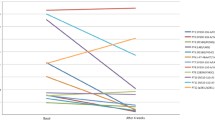Abstract
In phenylketonuria, compliance and diet is a difficult issue; it is hard to quantify and is under-researched. It is influenced by many factors. Failure to consume prescribed quantity of protein substitute has been commonly reported and is probably affected by their acceptability, format and timing of administration. There are few reports documenting actual phenylalanine intake and blood phenylalanine control, but it is possible that the more rigorous systems for allocation of phenylalanine are associated with worse compliance. The dry, hard and insipid nature of many low protein products may lead to their under usage and consequent boredom and hunger. The diet becomes increasingly harder to maintain as children grow older and seek fewer constraints in their meals.
Conclusion In phenylketonuria, encouraging adherence to diet requires continual education, reinforcement and support from the family and professionals within the support team.
Similar content being viewed by others
Author information
Authors and Affiliations
Rights and permissions
About this article
Cite this article
MacDonald, A. Diet and compliance in phenylketonuria. Eur J Pediatr 159 (Suppl 2), S136–S141 (2000). https://doi.org/10.1007/PL00014375
Issue Date:
DOI: https://doi.org/10.1007/PL00014375




